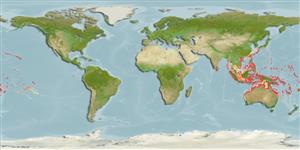Common names from other countries
Environment: milieu / climate zone / depth range / distribution range
Écologie
marin récifal; profondeur 0 - 36 m (Ref. 1602). Tropical; 30°N - 30°S, 77°E - 124°W
Indo-Pacific: Sri Lanka to the Hawaiian, Marquesan and Ducie islands, north to southern Japan, south to Lord Howe and Rapa Islands; throughout Micronesia.
Taille / Poids / Âge
Maturity: Lm ? range ? - ? cm
Max length : 20.0 cm TL mâle / non sexé; (Ref. 9710)
Épines dorsales (Total): 12 - 13; Rayons mous dorsaux (Total): 24-28; Épines anales 3; Rayons mous anaux: 20 - 23. Body is white with orange to orange-brown oblique bands on the sides. Two broad yellow-edged black bars are on the head; one running across the eye and another on the snout (Ref. 4855). Snout length 2.6-3.2 in HL. Body depth 1.3-1.6 in SL (Ref. 90102).
Occur in clear waters and coral-rich areas of lagoon and seaward reefs. However, only common in seaward reefs (Ref. 1602). Benthopelagic (Ref. 58302). Juveniles are solitary, living among branching corals, while adults are almost always in pairs and are home-ranging. Feed exclusively on coral tissue (Ref. 1602). Oviparous (Ref. 205). Form pairs during breeding (Ref. 205). Minimum depth reported taken from Ref. 128797.
Life cycle and mating behavior
Maturité | Reproduction | Frai | Œufs | Fécondité | Larves
Distinct pairing (Ref. 205). Monogamous mating is observed as obligate, genetic and social (Ref. 52884).
Myers, R.F., 1991. Micronesian reef fishes. Second Ed. Coral Graphics, Barrigada, Guam. 298 p. (Ref. 1602)
Statut dans la liste rouge de l'IUCN (Ref. 130435)
CITES (Ref. 128078)
Not Evaluated
Menace pour l'homme
Harmless
Utilisations par l'homme
Pêcheries: intérêt commercial mineur; Aquarium: Commercial
Plus d'informations
RéférencesAquacultureProfil d'aquacultureSouchesGénétiqueElectrophoresesHéritabilitéPathologiesTraitementMass conversion
Outils
Articles particuliers
Télécharger en XML
Sources Internet
Estimates based on models
Preferred temperature (Ref.
115969): 24.8 - 29.3, mean 28.4 (based on 2134 cells).
Phylogenetic diversity index (Ref.
82804): PD
50 = 0.5000 [Uniqueness, from 0.5 = low to 2.0 = high].
Bayesian length-weight: a=0.02291 (0.01133 - 0.04632), b=3.00 (2.83 - 3.17), in cm Total Length, based on LWR estimates for this Genus-body shape (Ref.
93245).
Niveau trophique (Ref.
69278): 3.3 ±0.61 se; based on food items.
Résilience (Ref.
120179): Haut, temps minimum de doublement de population inférieur à 15 mois (Preliminary K or Fecundity.).
Fishing Vulnerability (Ref.
59153): Low vulnerability (10 of 100).
